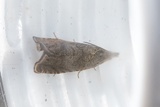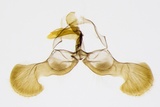Dichrorampha aeratana (Pierce & Metcalfe, 1915) Species
Last modified: Dec. 4, 2024, 3:26 p.m.
Status insufficiently known, because most of the species of this genus should be checked for genitalia. It is assumed that it is an uncommon species in Belgium.
Distribution based on specimens that have been checked for genitalia.
Details
- Classification
- Family: Tortricidae > Subfamily: Olethreutinae > Tribus: Grapholitini > Genus: Dichrorampha > Species: Dichrorampha aeratana
- Vernacular names
- Asgrauwe wortelmot (NL), Obscure Drill, Dingy Daisy Moth (EN), Aschgraue Wurzelmotte (DE)
- First mention in Belgium
- De Prins W. 1979. Dichrorampha aeratana (Pierce & Metcalfe) een nieuwe soort voor de Belgische fauna (Lep., Tortricidae). — Phegea 7: 69–70. On page 69. view page
- Status
-
Native
First observation in Belgium on 1977-06-18 at Baraque Fraiture (LX), leg. B. Maes, gen. det. W. De Prins.
Distribution
Imago
Wingspan 12–16 mm. A brown species with prominent glossy ochre tips to the scales from the wing base that give it a more peppered appearance than most other Dichrorampha species. Silvery and grey banded cilia. The pale costal strigulae are conspicuously present from one third, or less, subtending oblique plumbeous striae. The termen has prominent black spots.
Genitalia dissection is required to confirm identification.
Bionomics
The larva bores in the roots where it hibernates and later pupates in a cocoon in the soil.
Males are on the wing in the afternoon during warm sunny weather and both sexes fly about the foodplant at dusk and later come to light.
Flight periods
The adults are on the wing from mid-April towards mid-August.
Observed on
- Host plant (species):
- Leucanthemum vulgare
The larva feeds on Leucanthemum vulgare. The reference in the literature to Tanacetum vulgare is doubtful.
Habitat
It inhabits flowery grasslands and roadsides.


